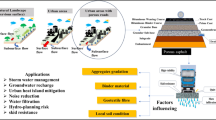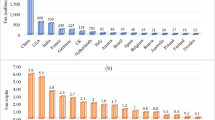Abstract
Stockpiles of discarded tires are a global concern. Since tire incinerating results in severe air pollution, reusing tires as tire rubber particles can reduce environmental pollution. A recycled tire, including rubber and recycled steel fiber, can be introduced in cement concrete. This study aimed to investigate the effects of crumb rubber and recycled steel fiber on the conventional concrete pavement's short- and long-term performance. The impact of crumb rubber (Cr) (0–20%) and recycled steel fiber (F) (0–0.5%) on the compressive, splitting, and flexural strength, as well as abrasion and freezing–thawing resistance of concrete, was evaluated through response surface methodology (RSM). The results indicated that fiber's addition to the concrete mix had a remarkable influence on flexural strength in low content and enhanced post-cracking ductility of rubberized concrete. Furthermore, incorporating crumb rubber as fine aggregate led to a reduction in the abrasion resistance and increased sensitivity to freezing–thawing in the presence of saline solution. According to optimization results, the most appropriate way to benefit from the desirable characteristics of rubberized concrete while minimizing the crumb rubber inclusion's adverse effects is through the addition of fibers into the concrete mixtures.














Similar content being viewed by others
Data Availability
Some or all data or models that support the findings of this study are available from the corresponding author upon reasonable request.
Abbreviations
- Cr :
-
Crumb rubber
- F :
-
Fiber
- Fc :
-
Compressive strength
- Ff :
-
Flexural strength
- Ft :
-
Indirect tensile strength
References
Kazemian, F., Rooholamini, H., & Hassani, A. (2019). Mechanical and fracture properties of concrete containing treated and untreated recycled concrete aggregates. Construction and Building Materials. https://doi.org/10.1016/j.conbuildmat.2019.03.179
Rooholamini, H., Bayat, A., & Kazemian, F. (2020). Mechanical and fracture properties of alkali activated concrete containing different pozzolanic materials. Road Materials and Pavement Design. https://doi.org/10.1080/14680629.2020.1845783
Thomas, B. S., Gupta, R. C., Kalla, P., & Cseteneyi, L. (2014). Strength, abrasion and permeation characteristics of cement concrete containing discarded rubber fine aggregates. Construction and Building Materials, 59, 204–212
Yung, W. H., Yung, L. C., & Hua, L. H. (2013). A study of the durability properties of waste tire rubber applied to self-compacting concrete. Construction and Building Materials, 41, 665–672
Li, L., Ruan, S., & Zeng, L. (2014). Mechanical properties and constitutive equations of concrete containing a low volume of tire rubber particles. Construction and Building Materials, 70, 291–308
Thomas, B. S., & Gupta, R. C. (2016). A comprehensive review on the applications of waste tire rubber in cement concrete. Renewable and Sustainable Energy Reviews, 54, 1323–1333
Mohammed, B. S., & Adamu, M. (2018). Mechanical performance of roller compacted concrete pavement containing crumb rubber and nano silica. Construction and Building Materials, 159, 234–251
Sukontasukkul, P., & Chaikaew, C. (2006). Properties of concrete pedestrian block mixed with crumb rubber. Construction and Building Materials, 20, 450–457
Holmes, N., Browne, A., & Montague, C. (2014). Acoustic properties of concrete panels with crumb rubber as a fine aggregate replacement. Construction and Building Materials, 73, 195–204
Güneyisi, E., Gesoǧlu, M., & Özturan, T. (2004). Properties of rubberized concretes containing silica fume. Cement and Concrete Research, 34, 2309–2317. https://doi.org/10.1016/j.cemconres.2004.04.005
Youssf, O., ElGawady, M. A., Mills, J. E., & Ma, X. (2014). An experimental investigation of crumb rubber concrete confined by fibre reinforced polymer tubes. Construction and Building Materials, 53, 522–532
Aiello, M. A., & Leuzzi, F. (2010). Waste tyre rubberized concrete: properties at fresh and hardened state. Waste Management, 30, 1696–1704
Ganjian, E., Khorami, M., & Maghsoudi, A. A. (2009). Scrap-tyre-rubber replacement for aggregate and filler in concrete. Construction and Building Materials, 23, 1828–1836
Alsaif, A., Koutas, L., Bernal, S. A., Guadagnini, M., & Pilakoutas, K. (2018). Mechanical performance of steel fibre reinforced rubberised concrete for flexible concrete pavements. Construction and Building Materials, 172, 533–543
Su, H., Yang, J., Ling, T.-C., Ghataora, G. S., & Dirar, S. (2015). Properties of concrete prepared with waste tyre rubber particles of uniform and varying sizes. Journal of Cleaner Production, 91, 288–296
Bravo, M., & De Brito, J. (2012). Concrete made with used tyre aggregate: Durability-related performance. Journal of Cleaner Production, 25, 42–50. https://doi.org/10.1016/j.jclepro.2011.11.066
Elchalakani, M. (2015). High strength rubberized concrete containing silica fume for the construction of sustainable road side barriers. Structures., 1, 20–38. https://doi.org/10.1016/j.istruc.2014.06.001
Sukontasukkul, P., & Tiamlom, K. (2012). Expansion under water and drying shrinkage of rubberized concrete mixed with crumb rubber with different size. Construction and Building Materials, 29, 520–526. https://doi.org/10.1016/j.conbuildmat.2011.07.032
Chen, X., & Solaimanian, M. (2019). Evaluating fracture properties of crumb rubber modified asphalt mixes. International Journal of Pavement Research and Technology, 12, 407–415. https://doi.org/10.1007/s42947-019-0048-6
Farina, A., Kutay, M. E., & Lanotte, M. (2021). Laboratory and field performance investigation of pre-swollen crumb rubber modified asphalt mixtures. International Journal of Pavement Research and Technology, 14, 513–518. https://doi.org/10.1007/s42947-020-0191-0
Kubair, S., Ravindra, W. A., Raju, S., & Ravindranath, S. (2020). Laboratory evaluation of gap graded rubber modified warm mix asphalt. International Journal of Pavement Research and Technology, 13, 558–569. https://doi.org/10.1007/s42947-020-0317-4
Kang, J., Zhang, B., & Li, G. (2012). The abrasion-resistance investigation of rubberized concrete. Journal of Wuhan University of Technology-Mater. Sci. Ed., 27, 1144–1148
Liew, K. M., & Akbar, A. (2020). The recent progress of recycled steel fiber reinforced concrete. Construction and Building Materials. https://doi.org/10.1016/j.conbuildmat.2019.117232
Noroozi, R., Shafabakhsh, G., Kheyroddin, A., & Mohammadzadeh Moghaddam, A. (2019). Investigating the effects of recycled PET particles, shredded recycled steel fibers and Metakaolin powder on the properties of RCCP. Construction and Building Materials, 224, 173–187. https://doi.org/10.1016/j.conbuildmat.2019.07.012
Grzymski, F., Musiał, M., & Trapko, T. (2019). Mechanical properties of fibre reinforced concrete with recycled fibres. Construction and Building Materials, 198, 323–331. https://doi.org/10.1016/j.conbuildmat.2018.11.183
Papakonstantinou, C. G., & Tobolski, M. J. (2006). Use of waste tire steel beads in Portland cement concrete. Cement and Concrete Research, 36, 1686–1691. https://doi.org/10.1016/j.cemconres.2006.05.015
Wong, S. F., & Ting, S. K. (2009). Use of recycled rubber tires in normaland high-strength concretes. ACI Materials Journal, 106, 325–332. https://doi.org/10.14359/56652
Aiello, M. A., Leuzzi, F., Centonze, G., & Maffezzoli, A. (2009). Use of steel fibres recovered from waste tyres as reinforcement in concrete: pull-out behaviour, compressive and flexural strength. Waste Management, 29, 1960–1970. https://doi.org/10.1016/j.wasman.2008.12.002
Pilakoutas, K., Neocleous, K., & Tlemat, H. (2004). Reuse of tyre steel fibres as concrete reinforcement. Engineering Sustainability, 157, 131–138. https://doi.org/10.1680/ensu.157.3.131.48644
Ahmadi, M., Farzin, S., Hassani, A., & Motamedi, M. (2017). Mechanical properties of the concrete containing recycled fibers and aggregates. Construction and Building Materials, 144, 392–398
Rooholamini, H., Hassani, A., & Aliha, M. R. M. (2018). Evaluating the effect of macro-synthetic fibre on the mechanical properties of roller-compacted concrete pavement using response surface methodology. Construction and Building Materials. https://doi.org/10.1016/j.conbuildmat.2017.11.002
Safari, J., Mirzaei, M., Rooholamini, H., & Hassani, A. (2018). Effect of rice husk ash and macro-synthetic fibre on the properties of self-compacting concrete. Construction and Building Materials. https://doi.org/10.1016/j.conbuildmat.2018.04.207
Fu, C., Ye, H., Wang, K., Zhu, K., & He, C. (2019). Evolution of mechanical properties of steel fiber-reinforced rubberized concrete (FR-RC). Composites Part B: Engineering, 160, 158–166. https://doi.org/10.1016/j.compositesb.2018.10.045
Gholampour, A., Ozbakkaloglu, T., & Hassanli, R. (2017). Behavior of rubberized concrete under active confinement. Construction and Building Materials, 138, 372–382. https://doi.org/10.1016/j.conbuildmat.2017.01.105
Gholampour, A., Fallah Pour, A., Hassanli, R., & Ozbakkaloglu, T. (2019). Behavior of actively confined rubberized concrete under cyclic axial compression. Journal of Structural Engineering, 145, 04019131. https://doi.org/10.1061/(asce)st.1943-541x.0002434
Khaloo, A. R., Dehestani, M., & Rahmatabadi, P. (2008). Mechanical properties of concrete containing a high volume of tire-rubber particles. Waste Management, 28, 2472–2482. https://doi.org/10.1016/j.wasman.2008.01.015
Richardson, A. E., Coventry, K. A., & Ward, G. (2012). Freeze/thaw protection of concrete with optimum rubber crumb content. Journal of Cleaner Production, 23, 96–103. https://doi.org/10.1016/j.jclepro.2011.10.013
Rooholamini, H., Hassani, A., & Aliha, M. R. M. (2018). Fracture properties of hybrid fibre-reinforced roller-compacted concrete in mode I with consideration of possible kinked crack. Construction and Building Materials, 187, 248–256
Xie, J. H., Guo, Y. C., Liu, L. S., & Xie, Z. H. (2015). Compressive and flexural behaviours of a new steel-fibre-reinforced recycled aggregate concrete with crumb rubber. Construction and Building Materials, 79, 263–272. https://doi.org/10.1016/j.conbuildmat.2015.01.036
Gesoğlu, M., Güneyisi, E., Khoshnaw, G., & İpek, S. (2014). Investigating properties of pervious concretes containing waste tire rubbers. Construction and Building Materials, 63, 206–213
Bignozzi, M. C., & Sandrolini, F. (2006). Tyre rubber waste recycling in self-compacting concrete. Cement and Concrete Research, 36, 735–739. https://doi.org/10.1016/j.cemconres.2005.12.011
Li, Z. (2011). Advanced concrete technology. John Wiley & Sons.
Siddique, R., Kapoor, K., Kadri, E. H., & Bennacer, R. (2012). Effect of polyester fibres on the compressive strength and abrasion resistance of HVFA concrete. Construction and Building Materials, 29, 270–278. https://doi.org/10.1016/j.conbuildmat.2011.09.011
Rashad, A. M. (2016). A comprehensive overview about recycling rubber as fine aggregate replacement in traditional cementitious materials. International Journal of Sustainable Built Environment, 5, 46–82
Montgomery, D. (2008) Design and Analysis of Experiments: Second Edittion, https://scholar.google.com/scholar?hl=en&as_sdt=0,5&q=D.C.+Montgomery,+Design+and+analysis+of+experiments,+John+Wiley+%26+Sons+2008 Accessed 27 May 2019.
Author information
Authors and Affiliations
Corresponding author
Rights and permissions
About this article
Cite this article
Zarei, A., Rooholamini, H. & Ozbakkaloglu, T. Evaluating the Properties of Concrete Pavements Containing Crumb Rubber and Recycled Steel Fibers Using Response Surface Methodology. Int. J. Pavement Res. Technol. 15, 470–484 (2022). https://doi.org/10.1007/s42947-021-00049-7
Received:
Revised:
Accepted:
Published:
Issue Date:
DOI: https://doi.org/10.1007/s42947-021-00049-7




